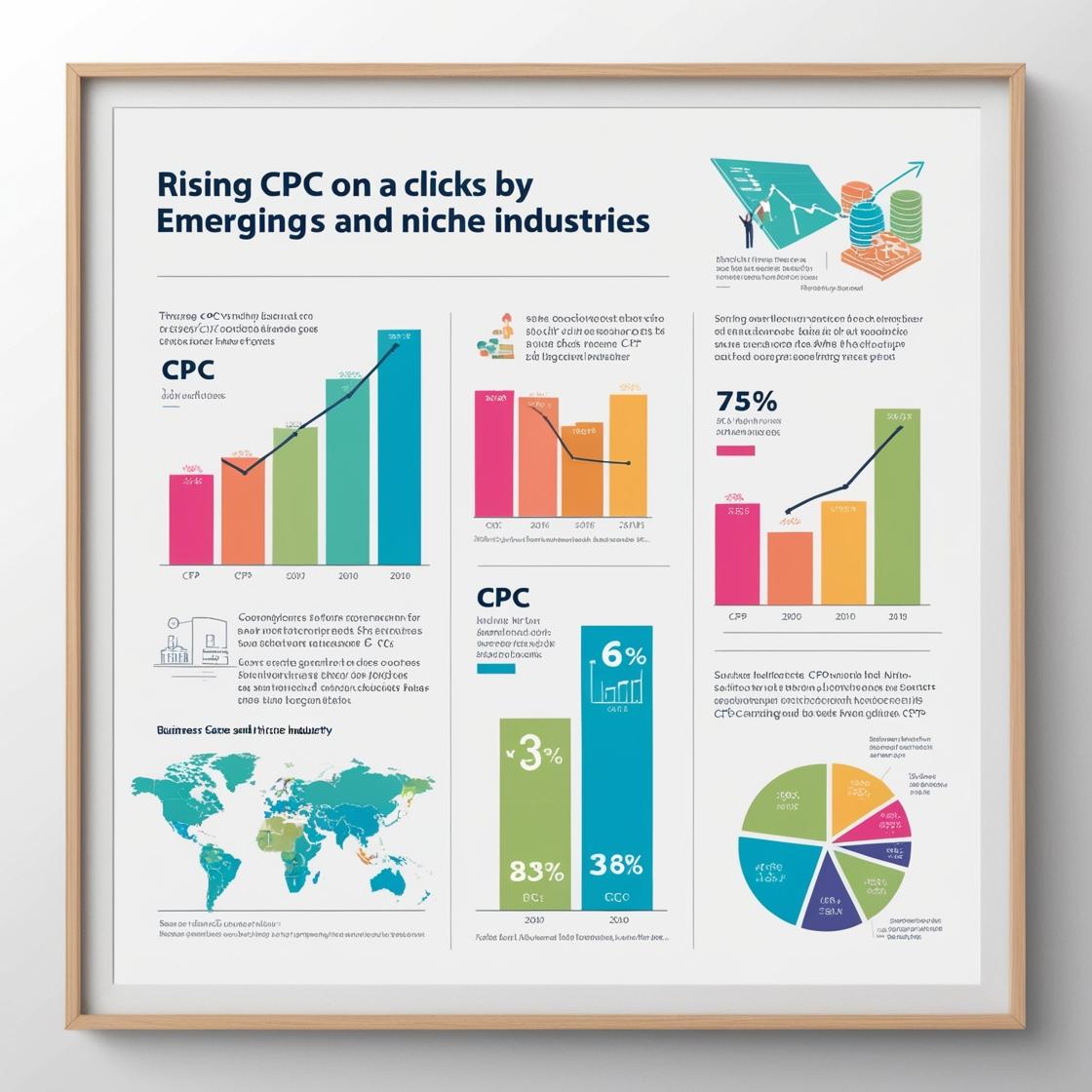What Rising CPC Means for Emerging Markets and Niche Industries
As digital marketing continues to evolve, pay-per-click (PPC) advertising remains one of the most effective tools for businesses to drive traffic and generate leads. However, with the growing competition for ad space, the cost-per-click (CPC) is on the rise. While this trend significantly impacts established industries, its implications for emerging markets and niche industries are even more profound.
This article explores how rising CPC affects businesses in these areas, why they are particularly vulnerable, and strategies to mitigate the challenges while maintaining growth.
Understanding CPC and Its Rising Trend
CPC refers to the amount advertisers pay every time a user clicks on their ad. In the PPC auction model, advertisers bid on keywords, and the cost is determined by factors such as keyword competition, ad relevance, and quality score.
In recent years, CPC rates have steadily increased due to:
- Growing competition: More businesses are entering the digital space.
- Advanced targeting: Platforms like Google Ads and Facebook Ads allow hyper-specific targeting, making ad space highly valuable.
- Economic pressures: Inflation and increased marketing budgets lead to higher bids for competitive keywords.
For emerging markets and niche industries, where budgets and resources are often limited, these rising costs can present significant challenges.
How Rising CPC Impacts Emerging Markets
Budget Constraints Limit Ad Reach
Emerging markets, often characterized by small and medium-sized enterprises (SMEs), typically operate with limited advertising budgets. Rising CPC rates mean that these businesses can afford fewer clicks for the same budget, reducing their ad reach and overall visibility.
Example:
A small business in an emerging market might allocate $500/month for PPC advertising. With CPC rates increasing from $1.50 to $2.50, the business can now afford only 200 clicks instead of 333, significantly reducing its ability to attract potential customers.
Increased Barriers to Entry
Higher CPCs make it difficult for new players in emerging markets to compete with established brands. Larger companies with substantial budgets dominate the ad space, leaving little room for smaller businesses to gain traction.
Example:
An online retailer in an emerging market competing with global giants like Amazon or AliExpress may find themselves priced out of high-traffic keywords like “affordable gadgets” or “best online deals.”
Limited ROI for High-Cost Keywords
In emerging markets, where consumer purchasing power may be lower, businesses must carefully balance ad spend against revenue generated. Rising CPCs can quickly erode profit margins, especially for keywords with a high cost but limited conversion potential.
Example:
An e-commerce store targeting “luxury watches” in an emerging market may see clicks that don’t convert due to the target audience’s lower disposable income, making the campaign unsustainable.
How Rising CPC Impacts Niche Industries
Hyper-Specific Keywords Become Costly
Niche industries often rely on specific, highly relevant keywords to target their audience. As competition grows, these keywords become more expensive, making it harder for niche players to afford ads.
Example:
A business selling artisanal, handmade soap may target keywords like “organic handmade soap,” which could see rising costs due to increasing competition from larger, eco-friendly brands.
Lower Search Volumes Amplify Costs
Niche industries frequently deal with low search volumes, as their products or services cater to a smaller audience. When CPCs rise, the cost of acquiring each customer becomes disproportionately high compared to broader industries.
Example:
A company offering specialized software for veterinary clinics may face high CPCs due to limited keyword options like “veterinary management software,” driving up customer acquisition costs.
Reduced Profit Margins
Since niche industries often have narrower profit margins due to smaller customer bases, rising CPCs can quickly diminish their profitability. Unlike mass-market businesses, they lack the scale to offset higher advertising costs.
Example:
A niche tourism operator focusing on eco-friendly expeditions might struggle to absorb rising CPC costs for keywords like “eco-friendly adventure tours.”
Why Rising CPC Is Particularly Challenging for These Sectors
- Limited Resources
Emerging markets and niche industries often lack the financial resources and in-house expertise needed to compete effectively in PPC bidding wars. - Dependence on Digital Channels
These sectors rely heavily on digital advertising to reach their audience, as traditional advertising methods are often too costly or inaccessible. - Price Sensitivity
Consumers in emerging markets and niche industries tend to be more price-sensitive, making it challenging to justify higher ad spend if it doesn’t directly lead to conversions. - Algorithmic Bias
Ad platforms prioritize advertisers with higher budgets and better-performing campaigns, further marginalizing smaller players.
Strategies to Navigate Rising CPC in Emerging Markets and Niche Industries
Focus on Long-Tail Keywords
Long-tail keywords are less competitive and more specific, often leading to higher conversion rates at a lower cost. Businesses can use tools like Google Keyword Planner or Ubersuggest to identify relevant long-tail opportunities.
Example:
Instead of targeting “handmade soap,” the business could target “organic lavender handmade soap for sensitive skin.”
Optimize for Quality Score
A higher quality score on platforms like Google Ads can lower CPCs. Businesses should focus on improving:
- Ad relevance to the target keyword.
- Landing page experience (e.g., fast load times, mobile optimization).
- Click-through rates (CTR) with compelling ad copy.
Leverage Alternative Advertising Channels
Diversifying ad spend across other channels, such as social media, influencer marketing, or email campaigns, can reduce dependency on high-CPC platforms.
Example:
Using Instagram ads or partnering with influencers in emerging markets can deliver results at a fraction of the cost of Google Ads.
Utilize Geo-Targeting
Geo-targeting allows businesses to focus their ads on specific regions where competition is lower, leading to reduced CPCs.
Example:
A small retailer in India could target Tier 2 or Tier 3 cities instead of metropolitan areas, where CPCs tend to be higher.
Prioritize Retargeting Campaigns
Retargeting focuses on users who have already interacted with your brand, increasing the likelihood of conversion and reducing overall CPC costs.
Example:
A niche SaaS provider could retarget users who visited their pricing page but didn’t sign up, delivering ads that address potential objections.
Build Organic Traffic Channels
Investing in long-term strategies like search engine optimization (SEO), content marketing, and social media engagement can reduce reliance on paid ads over time.
Example:
Creating blog posts and videos around “how to choose the best veterinary software” can attract organic traffic and nurture leads without additional ad spend.
Measure and Adjust Campaign Performance
Regularly reviewing campaign data allows businesses to identify underperforming keywords and optimize their budgets. Tools like Google Analytics and Facebook Ads Manager can provide actionable insights.
Looking Ahead: The Future of CPC in Emerging Markets and Niche Industries
While rising CPCs are challenging, emerging markets and niche industries have unique opportunities to adapt and thrive. The continued evolution of AI, automation, and alternative ad platforms offers promising solutions for managing costs and improving ROI.
Trends to Watch:
- First-Party Data Utilization: Businesses will rely more on first-party data to create highly targeted campaigns and reduce dependence on expensive, competitive keywords.
- AI and Automation: Advanced AI tools will help optimize bidding strategies, reducing wasteful spending.
- Alternative Platforms: The growth of regional ad networks in emerging markets and niche-specific platforms will create new opportunities for targeted advertising.
Rising CPCs present significant challenges for businesses in emerging markets and niche industries, but they are not insurmountable. By adopting creative strategies, optimizing campaigns, and diversifying their marketing efforts, businesses can mitigate the impact of rising costs while continuing to grow.
The key lies in leveraging their unique strengths—whether it’s deep audience insights in niche industries or untapped opportunities in emerging markets—and staying agile in a rapidly changing digital landscape.

